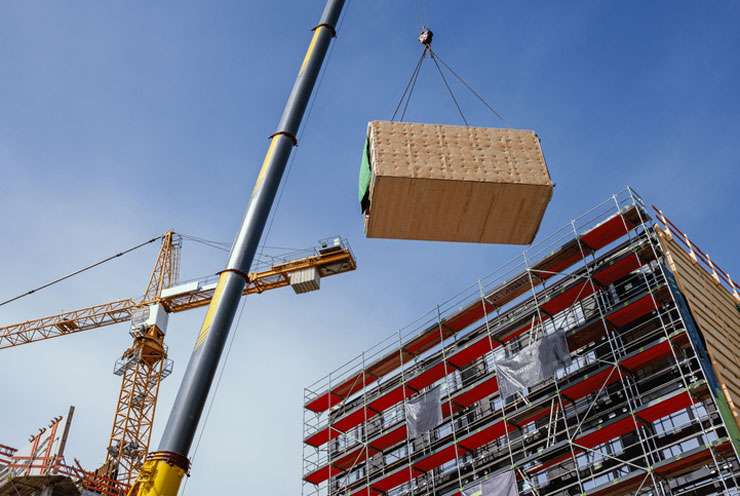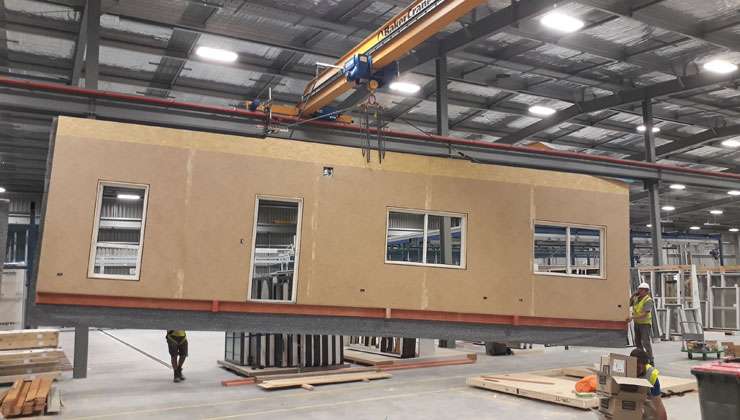Prefab homes look set to take off in New Zealand. The idea that homes can be built in the factory has long been dreamed of as a solution to New Zealand’s housing crisis. Red tape and a building industry that did things the old way has hampered the fast-tracking of prefab homes.
In the past 10 years the percentage of consents for prefab housing has grown from 3% in 2011 to more than 9% now, says PrefabNZ chief executive Scott Fisher.
Factory-built homes are usually produced faster, better, and more accurately than traditional tradie-built homes. They can be built undercover in the factory and construction can continue in all weathers.
Modern prefabrication involves either factory-built panels, which are erected on site, or modular homes craned into place on site and clipped together.
Start your property search
The build takes place in the factory at the same time as site works, reducing overall construction time. Previously site works would need to be complete before the build could begin, says Fisher.
Prefab homes have been used overseas to build at scale, says James Wilson, director of valuations at OneRoof’s data partner Valocity. It’s a particularly good way of building the more intensive housing that New Zealand needs, he says. “They’re definitely a part of the solution to our housing crisis.”
Wilson says the market struggled to take off for two reasons. “The first is this connotation that it means ‘knock ’em up cheap’. The second is that it has been quite difficult to get mortgage finance [for them].”
Pioneers have struggled. In 2018, when OneRoof last spoke with Tony Whale, general manager of Concision, his factory had capacity sitting idle. The business has taken off over the past three years, says Whale, in part thanks to larger orders from government building programmes.
“We have a number of projects with Kāinga Ora on the drawing board from single-storey houses to four to five-storey apartment buildings and transitional housing [as well].” The orders are sometimes for complete panels or room components, such as bathroom pods.

A prefab pod is put in place in an apartment development. Photo / Getty Images
The country’s largest home builder is slowly ramping up its production. Fletcher Building ran a trial in 2018 and went on to open its Clever Core prefab factory in Auckland’s Wiri in 2019. The purpose-designed, offsite home manufacturing facility builds homes in six to 10 weeks compared to 22 weeks for a standard build.
The factory is designed to manufacture up to 500 homes per year. In the 2021 financial year it produced 97 new homes, and 50 the previous year. Fletcher Building’s annual report predicted that 200 (one in five) Fletcher Living homes would be built in the factory in the current 2022 financial year.
One of the big roadblocks to prefab housing in New Zealand was the council consenting process, which was designed for onsite inspections, says Fisher.
The newly passed Building (Building Products and Methods, Modular Components, and Other Matters) Amendment Act 2021 has dealt with many of those problems, he says.
Regulations due to come into effect next year will complete the circle. “That's around improved consenting and factory certification.” The regulations will allow the prefab aspects of a new home to be consented in the factory and site signoff can take place separately.
Whale says councils have slowly become more familiar with offsite manufacturing, than they were. “We've [worked with] councils such as Auckland City Council in Christchurch in creating a Memorandum of Understanding so they take our quality assurance framework and utilise that in lieu of [onsite] inspection regimes,”
More and more prefab homes companies are launching in New Zealand. One new one is Hector Egger, a Swiss company that has launched an Otago based operation to build high-tech timber panels for residential and commercial building construction. Others include Red Stag Investments in Hamilton, Auckland based Smart Solution Homes, and XLam, an Australian cross laminated timber company that imports panels to its Mercer factory where it adds insulation, cladding systems, roofing and other features.

Inside Concision’s prefab factory. The company is working with Kāinga Ora to deliver hundreds of new homes. Photo / Supplied
A few companies import prefabricated homes from Asia. An example is Modul homes, which sells Chinese-built two story full size modular homes that are shipped in, trucked to a site, and craned into place where they clip together. Japan’s Panasonic Homes, which has built prefab homes in Te Kauwhata.
Many of these companies have landed contracts with Kāinga Ora in the past two years. Some find the government organisation moves very slowly, but they are grateful for the way it is supporting the industry. “We're getting really good traction through Kāinga Ora, and they are embracing off site manufacturing,” says Whale. “So, kudos to them.”
Kāinga Ora has found numerous efficiency benefits of offsite manufacturing (OSM), says ’s general manager construction and innovation Patrick Dougherty.
“OSM homes can be built and installed on sites faster, there are fewer variables to allow a more streamlined build process, materials are not exposed to the elements during construction, and less construction waste is produced,” says Dougherty. “Importantly, these homes meet quality and sustainability thresholds expected of a traditional build in New Zealand, including Healthy Homes standards and the New Zealand Green Building Council’s 6 Homestar ratings.
“OSM homes also allow the agility to respond to changes in housing need, as they can be relocated to areas as demand changes. “
Dougherty says around 15% of Kāinga Ora homes under construction or in design use OSM techniques.
He says one standout pilot is the 18-home Busby Street development in Blockhouse Bay, Auckland, built by Miles Construction.

Valocity director of valuation James Wilson: ““They’re definitely a part of the solution to our housing crisis.” Photo / Supplied
“The three-storey walk-up apartment buildings combine a mix of OSM technology, including Cross Laminated Timber panels from XLam. Engineered light timber frame panels and factory-built bathroom pods from Concision are also used. Busby Street has also become our second development to achieve a 7 Homestar rating.”
Concision has built 200 homes for Kāinga Ora over the past 18 months and expects to double that number over the same period going forward. “So, 200 front doors hoping to double that.”
The homes vary from standalone units to multi-story projects.
Despite the growth in the industry around 90% of framing in new homes is built onsite using traditional methods. If that was the other way around the building of new homes could be fast tracked, says Fisher. “It is something that really needs to be embraced by the construction industry.”
One of the other roadblocks to prefab housing has been in mortgage finance. It’s risky for banks because they advance money before the actual home is delivered to site, says Wilson. Both Westpac and BNZ have products in the market, says Wilson and he expects to see more.
Westpac launched a product in 2019 to overcome this problem and has lent to 200 customers since then, says Gina Dellabarca, general manager for consumer banking and wealth at
"By offering a dedicated lending product for prefab homes, we're making it easier and safer for Kiwis to use innovative building methods, potentially saving them money and time."
Dougherty says looking at global markets such as Sweden and the UK, there is the potential to grow the market for OSM homes in New Zealand but scaling it up will take time.
“It will require a collaborative, ‘whole of government’ approach in partnership with industry to ensure consistent pipeline for OSM factories, underpinned by a common language of technical specifications that enable an integrated supply chain model, supported by new skills capabilities, and an education programme to assist market acceptance.”



